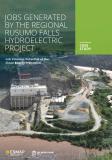Publications
The Ukrainian city of Lviv was able to reduce annual energy consumption in its public buildings by about 10 percent and tap water consumption by about 12 percent through aMonitoring and Targeting (M&T) program to control energy and water consumption. This generated an estimated net savings of 9.5 million UAH (US$1.2 million) as of 2010. The M&T program was launched in December 2006 and became fully operational by May 2007. It provided the city management with monthly consumption data for district heating, natural gas, electricity and waterin all of the city’s 530 public buildings. Under theprogram, utility use is reported and analyzed monthly; targets for monthly utility consumption are determined annually based on historical consumption and negotiations on an adjustment (in cases of foreseeable changes in consumption patterns). Actual consumption is reviewed monthly against the target, with deviations spotted and acted upon immediately and the performance of buildings is communicated to the public through a display campaign.
The M&T program achieved significant savings with minimal investment and recurring program costs. These utility bill reductions have been valuable in light of fiscal constraints and increasing energy prices. The program benefited from a crucial initial condition where most of the city’s public buildings were already metered for energy and water consumption and that the city had been collaborating with international aid programs in municipal energy since the late 1990s.
Strong city government leadership and commitment were key success factors of Lviv’s public buildings energy and water M&T program. A new Energy Management Unit (EMU) was established within the city administration and resources were mobilized to train all personnel with line responsibility on building utility use in an administrative division, unit, or building. The M&T system established responsibility, created transparency, and enabled informed control of energy and water use in public buildings, laying a solid foundation for sustained improvements in energy and water efficiency.




